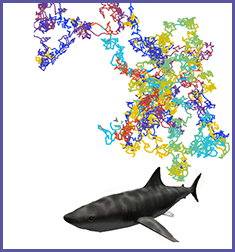

1. Simulation model for comparing the efficacy of methods for surveying mobile animals

As described in:
McCauley, DJ, McLean, KA, Bauer, J, Young, HS, and F Micheli. 2012. Evaluating the performance of methods for estimating the abundance of rapidly declining coastal shark populations. Ecological Applications 22: 385-392.
2. Datasets and data sources related to the causes, mechanisms, and consequences of marine defaunation.

See more of Peter Schouten's stunning extinct animal art in "A Gap in Nature"
As described in:
McCauley, DJ, Pinsky, ML, Palumbi, SR, Estes, JA, Joyce, FH, and RR Warner. 2015. Marine defaunation: animal loss in the global oceans. Science 347: 1255641.
Dates of first human arrival
- Estimated dates of first human arrival for selected geographic regions (Table S1) [xlsx]
Marine vs. terrestrial animal home range size
- Home range dataset (Table S2) [xlsx]
- Table coded as follows:
- BM= body mass (g)
- HR= home range (km2)
- System: M = Marine, T = Terrestrial
- Group: M = Mammals, B = Birds, R = Reptiles, F = Fishes
- Table coded as follows:
Full reference list (sources for Table S1 and Table S2 data)
- Full reference list for paper [doc]
Habitat modification data sets & data sources
- Global coral cover data from:
- E. R. Selig, K. S. Casey, J. F. Bruno, Temperature-driven
coral decline: The role of marine protected areas. Glob. Change
Biol. 18, 1561–1570 (2012). doi: 10.1111/j.1365-
2486.2012.02658.x [link] - J. F. Bruno, E. R. Selig, Regional decline of coral cover in the
Indo-Pacific: Timing, extent, and subregional comparisons.
PLOS ONE 2, e711 (2007). doi: 10.1371/journal.pone.0000711 [link]
- E. R. Selig, K. S. Casey, J. F. Bruno, Temperature-driven
- Global cover of mangroves (1980-2005) from:
- FAO, “The world’s mangroves 1980-2005. FAO Forestry Paper 153” (FAO, Rome, 2007). [link]
- Number of marine wind turbines (1991-2013) [csv]
- Area under international seabed mining contract (2000-2014+) [csv] [link]
- Global container port traffic (in TEU: 20-foot equivalent units) [csv] from:
- The World Bank (2000-2012) [link] (see description)
- Containerisation International Yearbooks (1974-1996 data)
- Number of dead zones in the global oceans by decade (1850-2000) from:
- Diaz, R J, and R Rosenberg. 2008. Spreading dead zones and consequences for marine ecosystems. Science, 321: 926-929. [link] (in Supplementary Materials)
- Ship strike data (1877-2010; International Whaling Commission) [link]